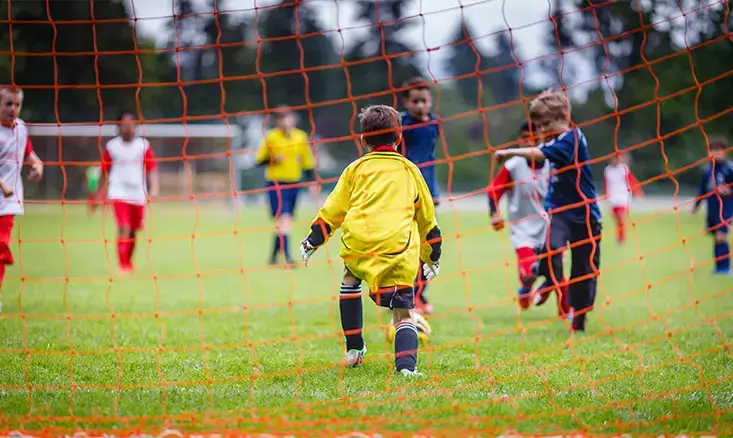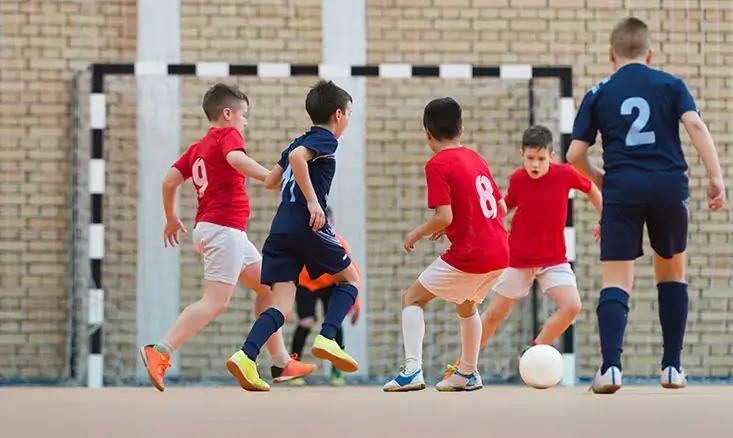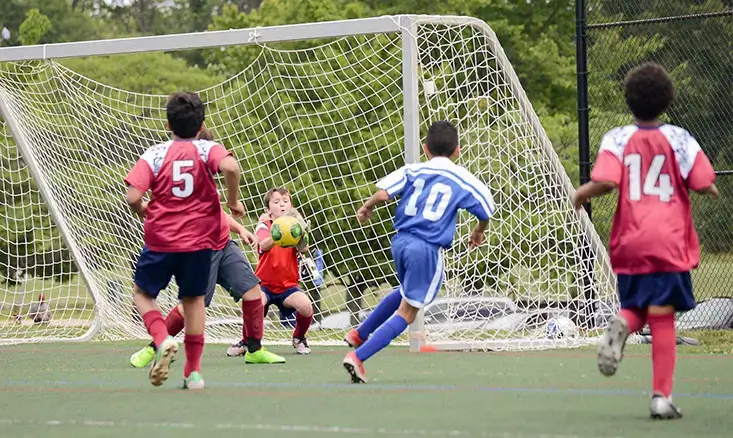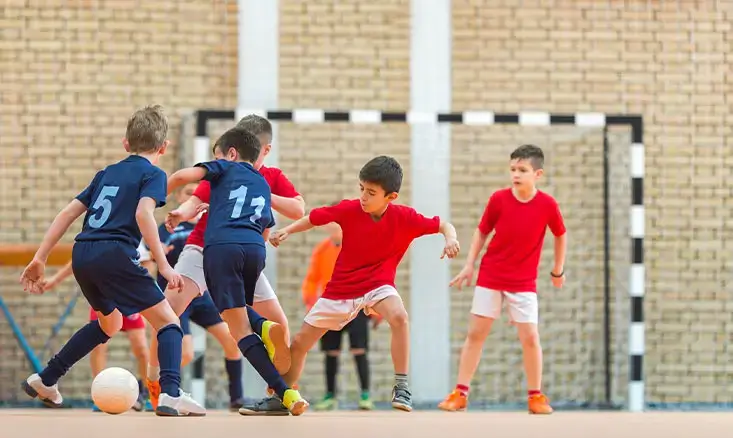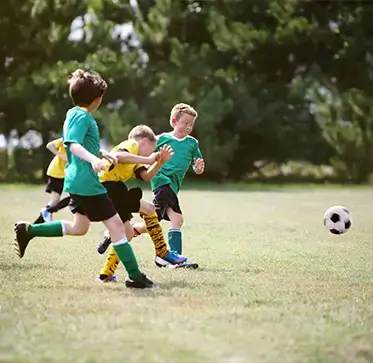In soccer, defense is as important as offense. Teaching youth soccer players effective defensive skills lays the groundwork for a well-rounded team. Good defenders prevent goals, support their teammates, and contribute to the overall success of the team. This guide will provide comprehensive soccer defense drills and tips to help youth soccer players develop strong defensive abilities.
Youth soccer players must learn to protect their goal and regain possession of the ball. By practicing soccer defense drills, they can develop the necessary techniques and instincts to become reliable defenders. These skills form the backbone of a well-coordinated team, enabling players to work together to prevent the opposing team from scoring.
Young players need a solid foundation in defensive principles. This includes understanding their role on the field, positioning themselves correctly, and knowing when to challenge opponents. These basics are covered in various soccer defense drills. A strong foundation helps players build confidence, enabling them to make quick, informed decisions during a game.
Awareness and positioning are key components of defense. Players must constantly be aware of the ball, their teammates, and the opposing players. Proper positioning helps them intercept passes and block shots effectively. Youth soccer drills that focus on awareness and positioning can significantly improve a player’s ability to read the game and react accordingly, making them more effective defenders.
Communication is vital in soccer defense. Players must communicate with each other to ensure everyone knows their responsibilities. Effective communication can prevent defensive breakdowns and lead to better team coordination. Teaching young players to communicate effectively on the field can help them work as a cohesive unit, making it difficult for opponents to find weaknesses in the defense.
Individual defensive drills are crucial for developing the fundamental skills necessary for effective defense. These drills focus on enhancing a player’s ability to tackle, intercept, and position themselves correctly. Incorporating these soccer defense drills helps build a solid foundation for young defenders.
One-on-one defending is a fundamental skill. Players learn how to maintain a defensive stance while forcing the attacker to make a move. Proper tackling techniques are taught to safely dispossess the opponent. Drills that focus on 1v1 situations help players develop confidence in their ability to handle attackers on their own, a crucial skill in any defensive strategy.
Proper positioning and body orientation can make a significant difference in defending. Players learn to position themselves between the ball and the goal, using their bodies to block the opponent’s path. These drills emphasize the importance of staying low, maintaining balance, and using quick footwork to stay with the attacker.
Anticipation is a crucial skill. By reading the attacker’s body language and movement, defenders can predict their next move and intercept the ball. These skills are developed through specific defense soccer drills. Developing the ability to anticipate plays can turn a good defender into an excellent one, capable of disrupting the opponent’s attacks before they become dangerous.
Pressing and interception drills are essential for teaching players how to disrupt the opponent’s play and regain possession quickly. These soccer defense drills for youth focus on closing down space, perfecting timing, and executing successful interceptions. Practicing these skills helps players become more effective and proactive defenders.
Pressing involves closing down space quickly to put pressure on the attacker. This disrupts their play and forces mistakes. Drills focus on speed and agility to effectively close down opponents. Learning to press effectively helps defenders take control of the game, forcing turnovers and creating opportunities for counter-attacks.
Interceptions require perfect timing and technique. Players practice reading the game and stepping in at the right moment to intercept passes. This skill is vital in breaking up the opponent’s attacks. Drills that focus on interception techniques help players develop quick reflexes and the ability to read the game, making them more effective in regaining possession.
The principles of pressure and cover are essential in team defense. One player pressures the ball while another provides cover, ready to support if needed. These principles are practiced in various soccer defense drills. Understanding and executing these principles can significantly improve a team’s defensive organization, making it harder for opponents to find gaps and exploit weaknesses.
2v2 and 3v3 group defensive drills are excellent for improving team coordination and communication. These youth soccer defense drills help players understand their defensive roles, support each other, and maintain a strong defensive structure. Practicing in small groups allows players to develop teamwork and tactical awareness in defensive situations.
Team coordination and communication are key in small-sided defending drills. Players work on understanding their roles, supporting each other, and communicating effectively to maintain a strong defensive line. These drills help players develop the teamwork necessary to defend effectively as a unit, rather than relying solely on individual efforts.
Each player has specific defensive roles and responsibilities. Drills help them understand these roles and how to execute their responsibilities effectively within the team structure. Understanding and fulfilling these roles is crucial for maintaining a cohesive and effective defensive strategy.
Zone defense drills focus on teaching players how to cover specific areas of the field effectively. These youth soccer defense drills emphasize maintaining team shape, covering spaces, and transitioning smoothly from attack to defense. Practicing zone defense helps young players understand spatial awareness and team coordination.
Zone defense focuses on covering specific areas of the field rather than marking individual players. Drills teach players to cover spaces effectively and maintain team shape. Zone defense can be particularly effective in preventing opponents from finding space to create scoring opportunities.
Transitioning from attack to defense quickly is crucial in soccer. Players practice switching roles and getting back into defensive positions as soon as the ball is lost. Effective transitions can catch opponents off guard and prevent them from launching quick counter-attacks.
Maintaining a defensive shape and structure prevents the opponent from finding gaps. Drills emphasize staying organized and compact, making it difficult for the opposing team to penetrate the defense. A well-organized defense can frustrate attackers and reduce their scoring chances.
Age-specific defensive drills are designed according to the developmental stages of youth soccer players, ensuring they learn appropriate skills at each level. These drills, including soccer defense drills for U10 and soccer defense drills for U12, focus on basic techniques for younger players and more advanced tactics for older players. Customizing drills by age helps maximize learning and skill development.
Soccer defense drills for U10 focus on fundamental skills such as basic tackling, blocking, and positioning. These drills are designed to be engaging, helping young players develop their defensive abilities while enjoying the game. By introducing these youth soccer defense drills early, players build a strong foundation for future development.
For younger players, basic tackling and blocking drills are essential. These drills focus on the fundamental techniques needed to stop attackers and regain possession. Teaching these basics early helps players develop good habits that will serve them well as they progress.
Introducing team defense concepts at an early age helps players understand the importance of working together. Drills focus on basic team defense principles suitable for this age group. Learning these concepts early sets the foundation for more advanced defensive strategies as players mature.
Soccer defense drills for U12 concentrate on more advanced techniques such as precise tackling, marking, and defensive positioning. These drills are designed to challenge players and improve their understanding of team defense concepts. Implementing these soccer defense drills for youth ensures players are well-prepared for competitive play.
As players progress to U12, more advanced tackling and marking drills are introduced. These drills help refine their defensive techniques and improve their ability to mark opponents. Advanced drills challenge players to think strategically and adapt to more complex game situations.
Small-sided games are effective in teaching defensive skills. These games simulate real match situations, helping players apply their defensive skills in a competitive environment. Small-sided games provide a balance of fun and competition, encouraging players to develop their skills while enjoying the game.
Defensive positioning and awareness are crucial at the U12 level. Drills focus on teaching players how to position themselves correctly and stay aware of the game’s dynamics. Developing these skills helps players make better decisions and react more effectively during matches.
Practical defensive tips for youth soccer players focus on enhancing their overall defensive performance. By incorporating these soccer defense tips, young players can develop strong defensive skills and contribute more effectively to their team.
Staying focused and alert is essential for good defense. Players must always be aware of their surroundings and anticipate the opponent’s moves. Maintaining concentration throughout the game can prevent losses in defense and reduce the likelihood of conceding goals.
Effective communication with teammates can make a significant difference in defense. Players should constantly talk to each other to ensure everyone knows their roles and responsibilities. Clear communication can prevent misunderstandings and improve team coordination.
Progressive drills that increase in difficulty help players build their skills gradually. This approach ensures that beginners are overwhelmed and can progress at their own pace. Gradual progression helps players develop a strong foundation and confidence in their abilities.
Encouraging teamwork and communication is vital. Coaches should emphasize the importance of working together and communicating effectively on the field. Teamwork and communication can significantly enhance a team’s defensive performance, making them more resilient and difficult to break down.
Constructive feedback helps players improve. Coaches should provide specific, positive feedback to help players understand their strengths and areas for improvement. Constructive feedback can boost players’ confidence and motivation, helping them strive for continuous improvement.
To develop strong defensive skills, youth soccer players need a combination of individual and team drills. Regular practice, effective communication, and a positive mindset are key to success. By incorporating these soccer defense drills and soccer defense tips, young players can enhance their defensive skills and contribute to their team’s success.
Youth soccer players can improve their defense by focusing on staying close to the opponent, keeping their eyes on the ball, and using proper tackling techniques to regain possession.
To become a better defender in soccer, focus on practicing regularly, improving your positioning and awareness, developing quick decision-making skills, maintaining physical fitness, and effectively communicating with your teammates to ensure cohesive defensive strategies.
In 1-on-1 soccer defense, position yourself between the opponent and the goal, stay low with a strong stance, and anticipate the attacker’s moves to block or tackle effectively.
The 5 principles of defending are pressure (on the ball), cover (supporting teammates), balance (maintaining team shape), compactness (staying close together), and control/restraint (avoiding unnecessary fouls).
To defend against a faster player, position yourself wisely to cut off their path, use your body to block their progress, and anticipate their moves to stay one step ahead.
